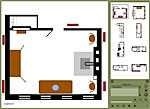Our Lord in the Attic: A Case Study
Sael
 When Hartman bought the house, he upgraded it to match his position as a wealthy tradesman. From 1661-1663 the most extensive building work was carried out: apart from the installation of a church in the attic, the main room in the house, the grand parlor, or 'sael' was installed.
When Hartman bought the house, he upgraded it to match his position as a wealthy tradesman. From 1661-1663 the most extensive building work was carried out: apart from the installation of a church in the attic, the main room in the house, the grand parlor, or 'sael' was installed.
Launch image viewer of the sael
Launch image viewer of floor plans
![]() Collection catalogue (PDF, 5.5MB)
Collection catalogue (PDF, 5.5MB)
![]() 'Description of area' database (PDF, 664KB)
'Description of area' database (PDF, 664KB)
![]() Database area reference key (XLS, 571KB)
Database area reference key (XLS, 571KB)
Description of the sael
This splendid, luxurious room, which is in a unique state of preservation, takes up two floors. The room was the Hartman family’s reception room, with an impressive interior richly executed in Dutch classical style. As traditional in seventeenth-century interiors, the furniture in the sael is placed along the walls.
Characteristic of the classically inspired architecture is the emphasis on symmetry in form and decoration. This style is based on Graeco-Roman architecture and is characterized by orderly grouping, symmetry and the use of ancient motifs. Everything matches. The pattern on the ceiling, for example, is reflected in the stone floor, while the fireplace is countered on the opposite wall by an inbuilt walnut cupboard.
 When entering the room the eye is immediately drawn to the fireplace with its twin supporting twisted columns of black marble veined with white. The entablature of the chimneypiece carries the coat of arms of Jan Hartman and his wife Lysbeth Jans, whose family were compass makers. It was a design of their own invention. On the chimneypiece above this is a seventeenth-century Dutch copy of a painting by the Venetian Andrea Schiavone (1510‑1563), depicting the Presentation in the Temple. The elderly Simeon is holding the infant Christ; Mary and Joseph stand on the left.
When entering the room the eye is immediately drawn to the fireplace with its twin supporting twisted columns of black marble veined with white. The entablature of the chimneypiece carries the coat of arms of Jan Hartman and his wife Lysbeth Jans, whose family were compass makers. It was a design of their own invention. On the chimneypiece above this is a seventeenth-century Dutch copy of a painting by the Venetian Andrea Schiavone (1510‑1563), depicting the Presentation in the Temple. The elderly Simeon is holding the infant Christ; Mary and Joseph stand on the left.
The wall opposite the chimney consists of an inbuilt walnut cupboard flanked on either side by a door. In fact, the door on the left is fake and is only there to preserve the symmetry of the salon. Black marble bands echo the pattern of the paneled ceiling in the white marble floor. The richly ornamented and partly gilded oak ceiling is decorated with garlands of floral and plant motifs.
Three large cross windows ensure that the salon is amply lit.
A series of paintings have been placed on the south wall to maintain the symmetry of the room. This way of arranging paintings came into fashion in the middle of the seventeenth century.
As traditional in seventeenth-century interiors, the furniture in the sael is placed along the walls. A remarkable item is the console table, made in Holland. The wooden support is painted to resemble marble and is so finely carved that the shape and decoration interweave.
Restoration history
 In the period 1999-2001, the canal room and sael were renovated and their 17th century interior reinstated. In the sael, several broken and damaged stone floor tiles were repaired or replaced. The painted wooden cassette ceiling was cleaned and cracks were filled in. The original plaster on the walls was uncovered and a door, which was at some point in time installed next to the chimney, was removed, in such a way that it is reversible.
In the period 1999-2001, the canal room and sael were renovated and their 17th century interior reinstated. In the sael, several broken and damaged stone floor tiles were repaired or replaced. The painted wooden cassette ceiling was cleaned and cracks were filled in. The original plaster on the walls was uncovered and a door, which was at some point in time installed next to the chimney, was removed, in such a way that it is reversible.



